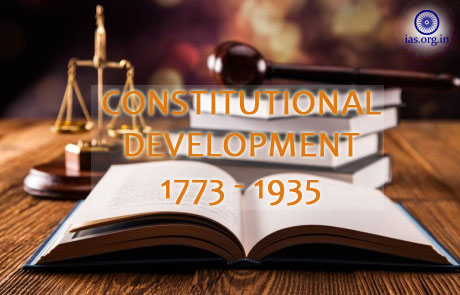Regulating Act, 1773
- End of Dual Government.
- Governor of Bengal to be the Governor- General of British territories of India.
- Established of Supreme Court in Calcutta
Pitts Act of 1784
- This Act gave the British Government a measure of control over the company’s affairs. In fact, the company became a subordinate department of the State.
Act of 1786
- Governor General given the power to over-ride the Council and was made the Commander-in-chief also.
Also Read: The Constitution of India – Drafting and Composition
Charter Act of 1793
- Company given monopoly of trade for 20 more years. It laid the foundation of Government by written laws, interpreted by courts.
Charter Act 1813
- Company deprived of its trade monopoly in India except in tea and trade with China.
Charter Act of 1833
- End of company’s monopoly even in tea and trade with China. Company was asked to close its business at the earliest.
- Governor General of Bengal to be Governor General of India. (1st Governor General of India was Lord William Bentinck).
Charter Act 1853
- The Act renewed the powers of the company and allowed it to retain the possession of Indian territoris in trust of the British crown.
- Recruitment to Civil Service was based on open annual competition examination (excluding Indian ).
Government of India Act, 1858
- Rule of Company in India ended that of the crown began.
- A post of Secretary of State (a member of the British Cabinet) for India . He was assisted bya 15-member council (called India Council). He was to exercise the powers of the Crown.
- Secretory of state Governed India through the Governor General.
- Governor General received the title of Viceroy. He represented Secretory of State and was assisted by an executives Council, which consisted of high officials of the Government.
Also Read: Constitution of India – Brief Introduction
Indian Council Act, 1861
- The executive Council was now to be called Central Legislative Council.
Indian Council Act, 1892
- Indians found their way in the provincial Legislative Council.
Indian Council Act, 1909 or Morley-Minto Reform
- It envisaged a separate electorate for Muslims.
Government of India Act, 1919 or Montague-Chelmsford Reforms
- Dyarchy system introduced in the provinces.
- The Provincial subjects of administration were to be divided into two categories : Transferred and Reserved .
- The Transferred subjects were to be administered by the Governor with the aid of ministers responsible to the Legislative Council.
- The Governor and the Executive Council were to administer the reserved subjects without any responsibility to the legislature.
- Indian legislature became bicameral for the first time. It actually happened after 1935 Act.
Government of India Act, 1935
- Provided for the establishment of all-India Federation consisting of the British Provincially and the Princely States.
- The joining of Princely States was voluntary and as a result the Federation did not come into existence.
- Dyarchy was introduce at the Centre (e.g., Department of Foreign Affairs and Defence were reserved for the Governor General).
- Provincial autonomy replaced Dyarchy in provinces. They were grants separate legal identity. Burma (now Myanmar) separated from India.
Also Read: 20 Features of Indian Constitution



